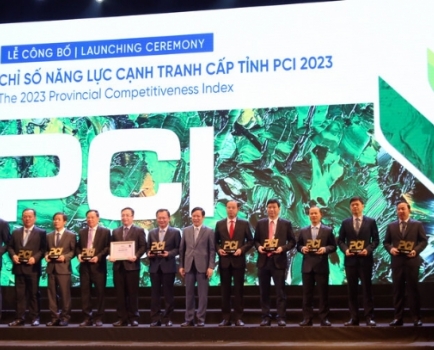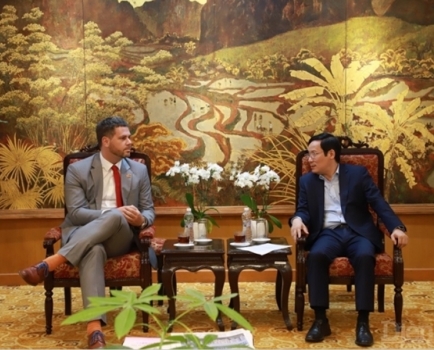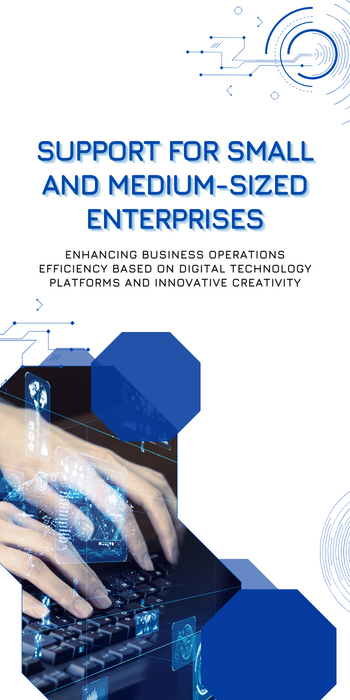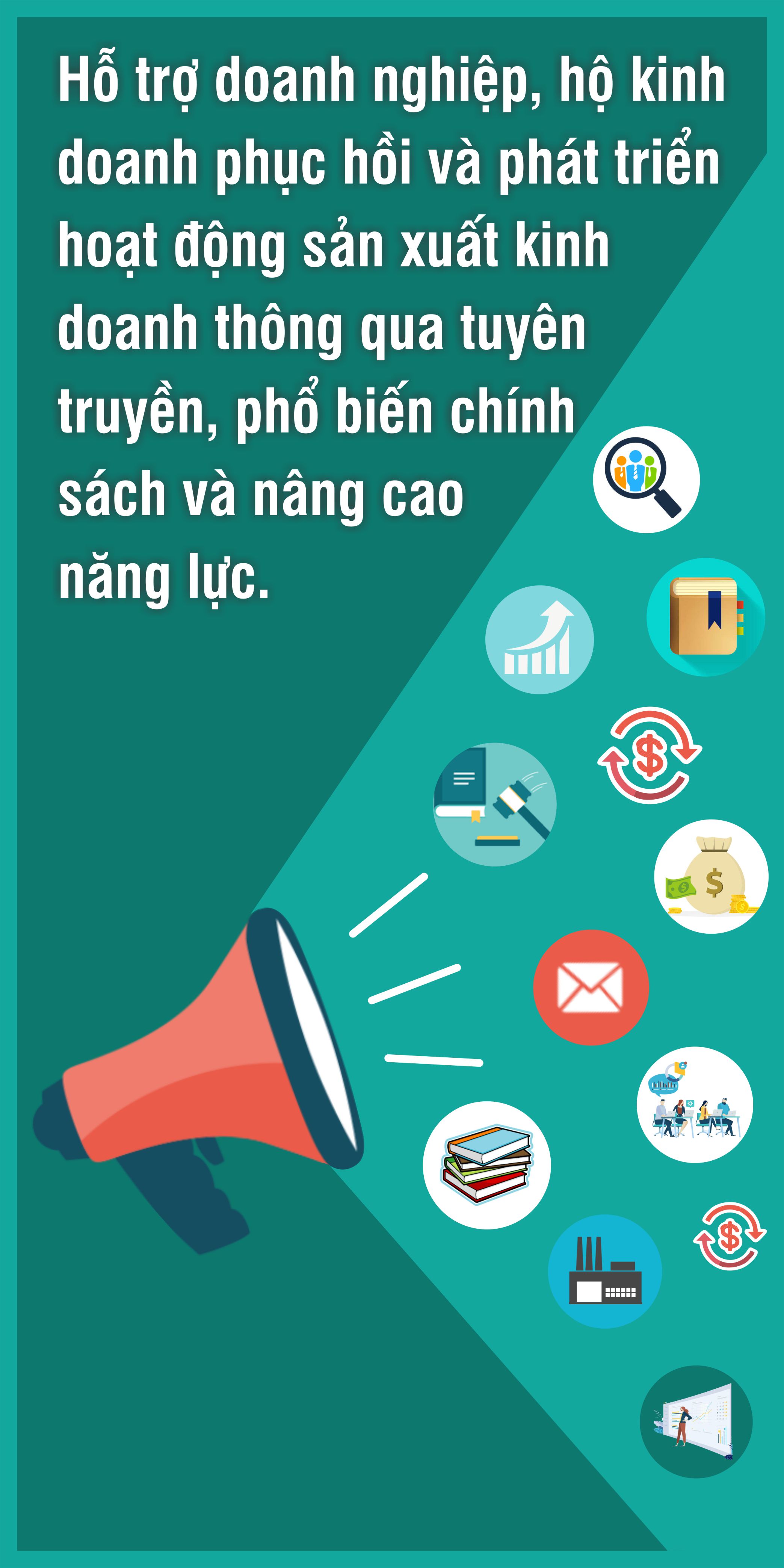Eastern Highway Industrial Zone Development Linkage
Sat, 16 Sep 2023 09:07:00 | Print | Email Share:
Forum: The Eastern Highway Industrial Zone Development Linkage Forum is directed by the VCCI and the People's Committee of Hai Phong City. The Business Forum magazine, in collaboration with the Hai Phong Department of Planning and Investment, organized this event on August 31, 2023, in Hai Phong City.
On April 21, 2022, the Government issued Resolution No. 57/NQ-CP on tasks and solutions to improve the regional economic and social connectivity system. It emphasized the proactive role of linkage among provinces and cities.
In line with the spirit of Resolution 57, on July 28, 2022, VCCI and four provinces, namely Quang Ninh, Hai Phong, Hai Duong, and Hung Yen, signed a cooperation agreement to connect the Eastern High-Speed Economic Corridor. This agreement aims to enhance regional connectivity, strengthen coordination, leverage the potential and advantages of the four regions along the Hanoi-Hai Phong-Mong Cai expressway corridor, and stimulate high growth in the Red River Delta region.
To realize the Economic Corridor Connection Agreement and provide an overview of industrial zones and clusters in the Eastern Highway Corridor provinces, creating favorable conditions for joint ventures and partnerships among businesses, efficient utilization of investment resources, and infrastructure development to improve competitiveness. It also seeks to identify domestic and international investment promotion opportunities.
Simultaneously, the feedback and contributions of experts, scientists, relevant organizations, and the timely feedback and suggestions from businesses are utilized to address the tasks and solutions of the cities, resolve business challenges and obstacles, and create conditions for businesses to develop industrial infrastructure, taking advantage of the strengths of the Eastern Highway Corridor and the unique characteristics of each locality.

Overview of the "Eastern Highway Industrial Zone Development Linkage Forum."
Under the guidance of the Vietnam Chamber of Commerce and Industry (VCCI), the People's Committee of Hai Phong City, the People's Committee of Quang Ninh Province, the People's Committee of Hung Yen Province, and the People's Committee of Hai Duong Province, in collaboration with the Business Forum magazine, VCCI's Regulatory Board, the Department of Planning and Investment of Hai Phong, and the Management Board of Economic and Industrial Zones in Hai Phong, Quang Ninh, Hai Duong, and Hung Yen provinces, jointly organized the "Eastern Highway Industrial Zone Development Linkage Forum" at the Hai Phong Conference Center, 18 Hoang Dieu Street, Hai Phong City, on the afternoon of August 31, 2023.
The conference was attended by Mr. Le Tien Chau, Central Committee member of the Communist Party of Vietnam and Secretary of the Hai Phong Party Committee; Mr. Nguyen Van Tung, Deputy Secretary of the Municipal Party Committee and Chairman of the People's Committee of Hai Phong City; Mr. Le Anh Quan, Permanent Deputy Chairman of the People's Committee of Hai Phong City; Mr. Nguyen Le Huy, Permanent Deputy Chairman of the People's Committee of Hung Yen Province; Mr. Tran Van Quan, Deputy Chairman of the People's Committee of Hai Duong Province.
Representing VCCI, Mr. Pham Tan Cong, Chairman of the Vietnam Chamber of Commerce and Industry (VCCI), was in attendance.
Among the experts and speakers participating in the program were: Ms. Tran Thi Hong Minh, Director of the Central Institute for Economic Management Research; Mr. Nguyen Hong Quang, Deputy Head of the Environment Department at the Ministry of Natural Resources and Environment; Mr. Hoang Trung Kien, Head of the Management Board of Economic and Industrial Zones in Quang Ninh Province; Mr. Nguyen Trung Kien, Head of the Management Board of Industrial Zones in Hai Duong Province; Mr. Pham Truong Tam, Head of the Management Board of Industrial Zones in Hung Yen Province; Mr. Bui Ngoc Hai, Deputy Head of the Management Board of Economic and Industrial Zones in Hai Phong City; Mr. Dang Viet Dung, Chairman of the Vietnam Construction Association; Prof. Ha Ton Vinh; Mr. Tran Tien Dung; Members of the Vietnam Logistics Association (VLA) Executive Committee and Chairman of the Hai Phong Logistics Association; Mr. Dau Anh Tuan, Deputy Secretary General and Head of the Regulatory Board at VCCI, and a member of the Scientific Council of the National Assembly's Standing Committee, advising on the content and coordination of the Forum.
On the part of the implementing unit, there were: Ms. Tran Thi Hai Yen - Deputy Director of the Hai Phong Department of Planning and Investment; Mr. Nguyen Linh Anh - Deputy Editor-in-Chief in charge of the Business Forum magazine.
The program also had the participation of leaders from local departments and agencies, customs departments of provinces, central and local business associations, management boards of economic and industrial zones in the four provinces of Hung Yen, Hai Duong, Hai Phong, and Quang Ninh; as well as major corporations, enterprises, and prominent entrepreneurs representing industrial infrastructure companies, manufacturing businesses, logistics, construction contractors, central and local media organizations.
The organizers would like to express their gratitude for the support and collaboration of Frasers Property Vietnam, Xuan Cau Lach Huyen Investment Corporation, Core5 Vietnam, DEEP C Industrial Zones, and all the accompanying enterprises and investors.
The program is currently being broadcast live on the Business Forum electronic magazine website www.diendandoanhnghiep.vn and the Business Forum fan page.
"A CRUCIAL STEP FOR INDUSTRIALIZATION"
In his opening remarks at the Forum, Mr. Pham Tan Cong, Chairman of VCCI, shared that on February 28, 2023, in Hung Yen, leaders from the four localities of Hai Phong, Quang Ninh, Hung Yen, Hai Duong, and VCCI gathered to discuss the implementation of the specific contents of the Economic Corridor Connection Agreement in accordance with the government's policy on economic development collaboration.
Several specific contents have been implemented, and the "Eastern Highway Industrial Zone Development Linkage Forum" is a continuation of the regional collaboration activities initiated by these localities in the area.

Mr. Pham Tan Cong, Chairman of the Vietnam Chamber of Commerce and Industry (VCCI), conveyed the following message: "As we are aware, the saying 'if you want to go far, go together' holds true. Therefore, in the development of industrial zones (IZs), it is crucial for us to collaborate, connect, and establish infrastructure links for these zones. The 13th Party Congress has set the ambitious goal of transforming our country into a high-income developed nation by 2045. To successfully achieve this objective, it is imperative for us to effectively industrialize and modernize our nation," emphasized the VCCI Chairman.
He underscored the significance of industrial zone development as a key step toward realizing this goal. In practice, countries worldwide, particularly those in the process of development, view industrial zones as an efficient model for advancing industrial sectors and attracting investments.
Mr. Pham Tan Cong disclosed that the four regions along the Eastern Highway presently host a total of 87 economic zones (EZs) and industrial zones (IZs). Among these, Hai Phong features the Dinh Vu - Cat Hai economic zone and 25 IZs, collectively covering an area of 12,702 hectares. Hai Duong boasts 24 IZs with a combined area of approximately 4,508 hectares. In contrast, Quang Ninh includes 5 EZs (comprising 3 border EZs and 2 coastal EZs) and 16 IZs, encompassing a total area of about 388,671 hectares. Hung Yen accommodates 17 industrial zones covering an area of 4,395.43 hectares.
Significantly, the IZs in these four provinces along the Eastern Highway employ a substantial workforce. Hai Phong alone employed 157,967 workers in its IZs by the end of 2020, while Hai Duong had around 102,014 laborers.

The four localities along the Eastern Highway currently have 87 economic zones (EZs) and industrial zones (IZs).
Notably, industrial zones make a significant contribution to local budgets and economic restructuring. Projects within these industrial zones have positively contributed to economic growth, generating numerous industries, products, new markets, accounting for nearly 80% of industrial production value, over 70% of export turnover, contributing to increased budget revenue, expanding markets, enhancing competitiveness, and international integration capability.
Looking at the entire country, according to statistics from the Ministry of Planning and Investment, in the national planning, there are approximately 563 industrial zones (IZs) in 61 out of 63 provinces and cities; 397 IZs have been established, and 292 IZs are already in operation, covering a total natural land area of approximately over 87.1 thousand hectares, with an industrial land area of over 58.7 thousand hectares.
Data from the Vietnam Real Estate Association (VARs) shows that as of the end of the first quarter of 2023, the occupancy rate of first-grade IZs nationwide continues to trend upwards, reaching over 80%, with the southern region averaging 85%, leading the country. Some industrial zones in Hanoi, Ho Chi Minh City, Dong Nai, Bac Ninh, Bac Giang, and Binh Duong are almost fully occupied.
Especially, in recent years, foreign direct investment (FDI) capital into industrial zones has accounted for approximately 35-40% of the total additional registered FDI capital of the country, and in the manufacturing and processing sector, this rate can go up to 70-80%. As of the end of 2022, the total registered investment capital in economic zones (EZs) and industrial zones (IZs) in Vietnam reached approximately USD 340 billion. In addition to the direct contributions mentioned above, the development of industrial zones has had a positive ripple effect on other areas of the economy, contributing to institutional improvement, enhancing the investment and business environment, and promoting administrative procedure innovation.
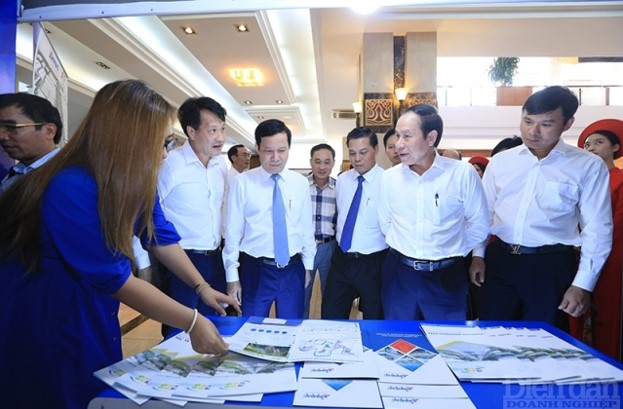



Exhibition on Eastern Highway Industrial Zones.
It can be observed that the occupancy rate of industrial zones (IZs) in this sub-region is currently around 50%. Among them, Hai Phong has the highest occupancy rate at approximately 60% (as of 2021) with an average investment rate of 9 million USD per hectare. Hai Duong, despite attracting 348 projects (as of June 30, 2023), has an average occupancy rate of about 51%. Quang Ninh, with 8 operational IZs, has a new occupancy rate of only 43%, lower than the national average. There are several IZs in the process of investment procedures with a total capital of 4.1 billion USD and 40 domestic projects with a capital of 21,000 billion VND. Hung Yen has 261 projects investing in its IZs with a total investment capital of 4.434 billion USD, but the occupancy rate in Hung Yen's IZs is currently 47.8%.
Despite achieving these important results, Chairman of VCCI candidly acknowledges that the development of industrial zones in recent times has also revealed some limitations. Specifically, the planning for industrial zone development has not clearly demonstrated a strategic vision and a holistic approach.
From the perspective of the provinces along the Eastern Highway, the planning and development of IZs in the four provinces and cities have exhibited certain shortcomings. In particular, despite being a key industrial region of the country, the growth rate of IZs has been slow, and many IZs have low occupancy rates. The ability to provide industrial services and technical infrastructure in some IZs is still limited. Most IZs face challenges in attracting large-scale, professional investors and lack proactivity in attracting secondary investors. The industrial manufacturing sector, which concentrates on attracting investors, resembles each other, reducing its attractiveness and competitiveness. Despite hosting many IZs, National Highway 5 is currently in a deteriorating condition. Regional value chain linkages are relatively low, and the raw material region lacks a significant scale. Additionally, the availability of industrial land, especially clean land with large areas for IZs, remains limited.

The Chairman of VCCI (Vietnam Chamber of Commerce and Industry) is working with local leaders in the Eastern Highway Axis and leaders from relevant ministries attending the forum.
In particular, the ability to address the infrastructure needs of social facilities serving industrial zones and economic zones, such as workers' housing, schools, hospitals, and research centers, has not been systematically invested in. Most of these are currently using the social infrastructure of nearby residential areas and towns.
On May 28, 2022, the government issued Decree No. 35/2022/ND-CP, "Regulations on the Management of Economic Zones and Industrial Zones," outlining the "directions for building, developing economic and industrial zone systems, infrastructure investment, establishment, operation, development policies, and state management of industrial zones and economic zones." The decree has oriented the development of economic zones, industrial zones, industrial-urban-service complexes, and eco-industrial zones, emphasizing energy efficiency, greenhouse gas emissions reduction, social responsibility, and government administration models. This represents a new trend in the development of industrial zones in our country today.
Furthermore, according to the industrial development plan for the provinces and cities along the Eastern Highway Axis by 2030, the total number of industrial zones in these areas is projected to reach 139 zones, an increase of 60 more zones. The total area of these industrial zones is 59,441 hectares, increasing by an additional 23,930 hectares, nearly doubling the current size. The current status of these industrial zones in actual operation is 15,913 hectares with an occupancy rate of 50.45%, which means the actual productive area of industrial zones is 8,028 hectares. The Chairman of VCCI believes this will be a significant challenge in implementing the plan to ensure effective land resource utilization. Additionally, labor resources and infrastructure conditions need to be specifically identified to contribute to the investment efficiency of these industrial zones.
Therefore, at the "Forum on Infrastructure Development Linkage for the Eastern Highway Axis Industrial Zones," the aim is to gradually realize the Economic Connectivity Agreement for the Eastern Highway Axis. "At the same time, we will provide an overview of investment and infrastructure development for industrial zones, economic zones in localities along the Eastern Highway Axis, promoting connections among domestic and foreign enterprises to invest and develop industrial zones, industrial clusters," emphasized Mr. Pham Tan Cong.
Simultaneously, the hope is that, from the suggestions and proposals of investors and businesses regarding the development and infrastructure linkage of industrial zones, as well as policy recommendations from provincial leaders at the forum, many solutions will be generated to develop and leverage the unique strengths of each industrial zone and locality.
"We hope that, after the forum, the development and linkage of industrial zones along the Eastern Highway Axis will become a model nationwide. It will also realize the idea of connecting the Eastern Highway Axis from concept to reality," emphasized the Chairman of VCCI.
UTILIZING THE STRENGTHS FOR INFRASTRUCTURE DEVELOPMENT IN INDUSTRIAL ZONES
Speaking at the forum, Mr. Nguyen Van Tung, Chairman of the People's Committee of Hai Phong City, stated that, situated within the economic region of the Eastern Highway Axis, the four localities: Hai Phong City, Quang Ninh, Hai Duong, and Hung Yen, have favorable geographical positions for economic development. In recent years, all four localities have been successful in attracting investment and development, becoming important regions for national economic growth.

Mr. Nguyen Van Tung - Chairman of the People's Committee of Hai Phong City
To expand the development space and enhance regional connectivity, Chairman of the People's Committee of Hai Phong City, Mr. Nguyen Van Tung, announced that on July 28, 2022, in Ha Long City, the leaders of the four localities and VCCI (Vietnam Chamber of Commerce and Industry) jointly signed an agreement on connecting the Eastern Highway Axis. Through this agreement, the localities have the opportunity to leverage their full potential and advantages for mutual development.
For Hai Phong City, Mr. Nguyen Van Tung, Chairman of the People's Committee of Hai Phong City, emphasized that it is identified as the growth pole of the key economic triangle in the Northern region. The city has significant strengths in regional economic integration and development. The average annual growth rate of the total product within Hai Phong City from 2021 to 2022 reached nearly 13%, which is twice the national growth rate. In the first six months of 2023, the city achieved a growth rate of nearly 10%. The Provincial Competitiveness Index ranks third, and the Administrative Reform Index ranks second among the 63 provinces and cities in Vietnam.
Currently, within Hai Phong City, there is the Dinh Vu Cat Hai Economic Zone covering over 22,500 hectares and 14 industrial zones spanning over 6,000 hectares. The average occupancy rate is over 60%, attracting investments of USD 38 billion, primarily from investors from Japan, South Korea, and the Vingroup conglomerate.
The Chairman of the People's Committee of Hai Phong City assessed that despite the relatively good investment attraction from the four localities, there is still a gap compared to other major economic centers. The quality of tourism and professionalism is not synchronized, and a seamless logistics chain has not been established. Therefore, the "Forum on Infrastructure Development Linkage for the Eastern Highway Axis Industrial Zones," according to Mr. Nguyen Van Tung, aims to help the four localities firstly address local challenges and leverage the strengths of each locality. It also aims to overcome the isolation in policy formulation and implementation among localities.
In addition, it seeks to enhance transportation infrastructure connectivity within the region, share experiences in state management, especially in developing infrastructure connections for industrial zones, and address investment attraction challenges, environmental resource management, and social issues among the localities.
NEED TO SOON COMPLETE THE LEGAL SYSTEM TO ENSURE CONSISTENCY AND UNIFORMITY
Sharing at the forum, Dr. Dang Viet Dung - Chairman of the Vietnam Construction Association, stated that the Red River Delta region has a long history of development closely associated with the nation's construction and defense efforts. It holds a particularly important position and role in the overall development of the country. The Red River Delta region comprises 11 provinces and cities, including Hanoi, Hai Phong, Quang Ninh, Vinh Phuc, Bac Ninh, Hai Duong, Hung Yen, Thai Binh, Ha Nam, Nam Dinh, and Ninh Binh. Within this region is the capital city of Hanoi, which serves as the political, economic, cultural, educational, and scientific-technological hub of the entire nation.
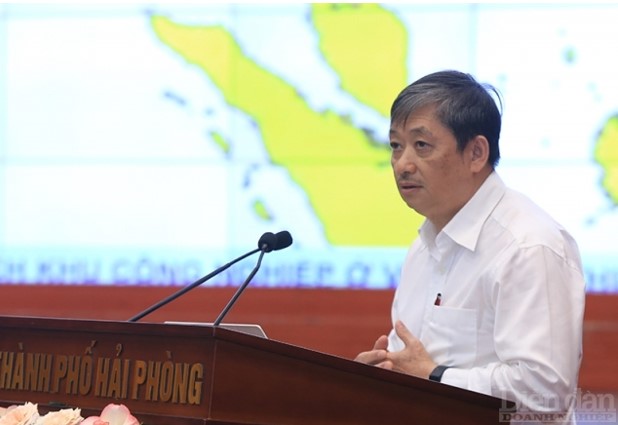
According to Mr. Dang Viet Dung - Chairman of the Vietnam Construction Association,
The Red River Delta region serves as the gateway to the East Sea (South China Sea) with the world and is one of the direct connectors between two dynamic development regions: Southeast Asia and Northeast Asia. It is also considered the northern gateway of Vietnam and ASEAN for economic development and trade connectivity with China, the world's largest market, and vice versa. The region has a comprehensive and well-connected transportation infrastructure system, including road, sea, river, air, and rail routes, with three economic corridors passing through.
Mr. Dung suggests that the spatial organization for the development of the Red River Delta region should be oriented towards the formation of two sub-regions. The Northern Red River Delta sub-region (also known as the Northern Key Economic Region) includes seven provinces and cities: Hanoi, Vinh Phuc, Bac Ninh, Hai Duong, Hung Yen, Quang Ninh, and Hai Phong.
Localities like Hanoi, Hai Duong, Hung Yen, Hai Phong, and Quang Ninh are situated along the highway connecting Hanoi, Hai Phong, and Mong Cai. Hanoi, Hai Phong, and Quang Ninh are the three growth poles in the economic development triangle.
"During the period from 2005 to 2020, the average economic growth of the Red River Delta region reached 7.94% per year, higher than the national average. The economic scale grew rapidly, reaching 2.37 million billion VND in 2020, accounting for 29.4% of the national GDP. The average GRDP per capita was 103.6 million VND per year, 1.3 times higher than the national average. The economic structure has positively shifted, with the industrial-construction and service sectors playing a pivotal role. Foreign investment attraction has increased significantly, urban development has grown rapidly, with an urbanization rate of over 41%. The economic-social infrastructure is well-invested, modern, and relatively synchronized, especially in transportation infrastructure. The roles of economic corridors and economic beltways have been effectively utilized. Resource management, environmental protection, and climate change adaptation are emphasized," Mr. Dung shared.

According to Mr. Dang Viet Dung - Chairman of the Vietnam Construction Association, the Northern Key Economic Region (NKER) has the second-largest economic scale in the country, accounting for 35.52% of the GRDP of the four Key Economic Regions (KERs) and nearly 32% of the national GDP. It contributes over 31% to the national budget, and its annual exports account for 32% of the national total. The economic structure is shifting in the right direction. The industrial-construction sector in the region continues to be the growth pillar, attracting large-scale foreign direct investment (FDI) projects, particularly those with high technology content and significant export value in the fields of electronics, telecommunications, mobile phones, automobile assembly, shipbuilding, and textiles. An auxiliary industry has begun to emerge in these sectors in Bac Ninh, Hanoi, and Hai Phong.
Since 2017, all provinces and cities within the NKER have contributed to the central budget, playing a significant role in the national budget revenue. It is the only key economic region where all localities make contributions to the central budget. As of 2018, the region had 44 industrial zones and two economic zones in operation, attracting over 8,444 FDI projects with a total registered capital of USD 91.061 billion, accounting for 36.16% of the total number of projects and 26.8% of the total registered investment capital in the country.
Several major and strategically significant transportation projects have been implemented, stimulating the region's development. These include the construction of highways such as Hanoi - Hai Phong (105.5 km) and Ha Long - Hai Phong (25 km), the establishment of economic corridors, and the development of key transport links connecting provinces within the region and other regions in the country. Additionally, investments have been made in expanding ports like Dinh Vu Port, Cai Lan Port, and the international gateway port in Hai Phong's Lach Huyen. These investments have contributed to the development of the logistics services and increased the competitiveness of this sector in comparison to the Southern Key Economic Region. The region boasts 27 logistics centers, representing 55% of the total logistics centers in the country, with the majority located in Bac Ninh (14), Hanoi (11), and Hai Phong (2).
However, alongside these positive aspects, this expert also noted that the economy of the Red River Delta region as a whole, and the Northern Key Economic Region in particular, still faces certain challenges. Economic growth in the region has not fully matched its potential and advantages, and it remains heavily reliant on capital and labor. Economic development levels among localities within the region are uneven, and the economic structural shift in some sectors is slow. The budget structure in some areas is not sustainable, depending on revenues from a few large-scale FDI projects.
To address the mentioned realities, Mr. Dang Viet Dung suggests that there is a need to promptly complete the legal system to ensure coherence and unity in responsibilities for management and investment among different ministries, sectors, and localities concerning industrial zones, economic zones, export processing zones, high-tech zones, industrial clusters, and the welfare of laborers. It's essential to improve regulations to establish uniform assignments among provinces and cities within the Northern Key Economic Region (NKER) to ensure the smooth and effective management of industrial zones.
Additionally, this expert also believes that the requirement to transition the development model of industrial zones (IZs) from the current model to specialized IZs, ecological industrial zones, and urban industrial zones is an essential direction. However, this transition process not only requires time and capital but also necessitates innovative planning and determination in execution, as well as the effort of all involved parties. Therefore, the government should establish guidelines for the transition process to ensure fairness and sustainable development in the future.
MOVING TOWARDS A CIRCULAR ECONOMY
Speaking at the forum, Mr. Nguyen Hong Quang, Deputy Head of the Environment Department (Ministry of Natural Resources and Environment), highly appreciates the initiative to sign the agreement on economic connectivity along the East-West highway axis, creating economic linkage among the four localities of Hai Phong, Quang Ninh, Hai Duong, and Hung Yen.
Regarding environmental protection efforts in recent times, the Ministry of Natural Resources and Environment has acknowledged and highly evaluated the efforts and concerns of the localities. In terms of environmental protection, there have been some results achieved in industrial zones, and these results are in compliance with legal regulations, especially the 2020 Environmental Protection Law.
Mr. Quang notes that currently, almost all industrial zones have wastewater treatment facilities, achieving nearly 100% coverage. Operating industrial zones and the enterprises within these zones have separate stormwater drainage systems from wastewater, ensuring compliance with legal regulations.

Mr. Nguyen Hong Quang - Deputy Head of the Environment Department (Ministry of Natural Resources and Environment)
Alongside this is the environmental quality monitoring system in industrial zones, which has gradually improved data from online and automatic monitoring, achieving approximately 100% coverage. Regular environmental quality monitoring programs have contributed to improving the environmental quality in industrial zones.
In addition to the achieved results, there are still issues related to investment in production and business service projects within industrial zones, as well as matters related to technology transfer. There are instances where outdated production technologies are imported, not ensuring environmentally friendly production, and resulting in significant energy consumption and waste generation.
"We have seen the efforts of localities in the process of participating in environmental protection in industrial zones. We hope that localities will continue to focus on building and enacting appropriate policies and mechanisms to support enterprises in industrial zones to implement cleaner production measures, proactively control the industrialization process in an environmentally friendly manner, promote the development of green industries and high technology industries, and limit the trend of scattered industrial production outside industrial zones and clusters. Furthermore, research and development of the recycling industry and the establishment of recycling industrial zones should be promoted," emphasized Mr. Nguyen Hong Quang.
Secondly, it is necessary to prioritize resources for investing in environmental protection technical infrastructure in industrial zones, such as stormwater collection systems and centralized wastewater treatment systems, ensuring wastewater treatment meets environmental protection standards. Investment in and construction of automatic and continuous wastewater monitoring systems should be accelerated, particularly in deploying centralized wastewater treatment systems in industrial zones.
For newly established industrial zones, it is crucial not to operate those that do not have completed centralized wastewater treatment systems. It should be ensured that, by 2025, 100% of industrial zones have centralized wastewater treatment systems in place, and all waste materials must be treated to meet environmental protection standards and regulations.
Mr. Nguyen Hong Quang commented that currently, most industrial zones have wastewater treatment stations, essentially reaching nearly 100%.
Thirdly, classify new investment projects based on their environmental impact from the initial investment approval process, to be assessed throughout the project's lifecycle. Particular emphasis should be placed on projects with a high potential for negative environmental impact. This needs to be carefully considered, especially for industrial zones moving towards eco-industrial zones.
Fourthly, control environmental pollution from secondary facilities within industrial zones through environmental permits based on automatic environmental assessments, environmental protection planning, environmental load capacity, and environmental technical standards. Enhance inspections and timely detection of environmental law violations for industrial zones or production service facilities within industrial zones. Regularly organize training and professional development for specialized departments in the Management Boards of industrial zones on environmental protection.
Fifthly, strengthen awareness among consumers of clean and environmentally friendly products to raise societal awareness of such products. This will encourage businesses to participate in building eco-industrial zones and producing green products. The promotion aims to enhance the awareness of businesses in industrial zones about environmental protection in general and environmental protection in particular for industrial zones in each locality.
"With a high determination, the collective effort of the community, and the efforts of the Management Boards, localities, and development partners, we hope that in the future, we will achieve even greater success in moving towards an economy based on the capacity of the circular economic ecosystem and achieve the goals of the ecosystems," expressed Mr. Nguyễn Hồng Quang.
ECOSYSTEM APPROACH AND INNOVATION
Speaking at the forum, Dr. Tran Thi Hong Minh, Director of the Central Institute for Economic Management (CIEM), believed that the development axis along the Eastern Expressway has many favorable conditions to form and develop the model of the "Creative Urban Area" with a system of industrial zones along four provinces/cities: Quang Ninh, Hai Phong, Hai Duong, and Hung Yen. The connection of this "Creative Urban Area" will effectively utilize resources, create a comprehensive strength, spread in the new context, create a vast and dynamic development space by maximizing the potential and advantages of localities along the axis, maximize the productivity of the local supply chain. Industrial zones along the axis will leverage each other's advantages and utilize the advantages of the important transportation connection with one end being the capital Ha Noi and the other end being the Mong Cai border gate, trading with the Chinese market.
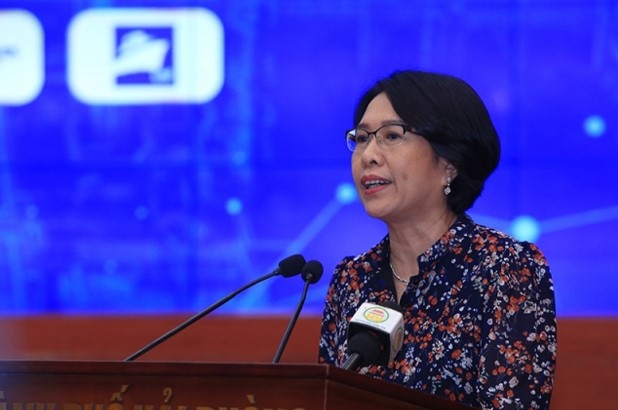
Dr. Tran Thi Hong Minh - Director of the Central Institute for Economic Management (CIEM)
In reality, in the four provinces along the Eastern Expressway, industrial zones are transitioning from phase 1 to phase 2, meaning they are gradually shifting from utilizing a large quantity of input factors such as capital, labor, and resources to effectively using these input factors. Additionally, many industrial zones have moved on to phase 2, a phase where efficiency is reached due to the input factors. In provinces and cities with a high urbanization rate, many industrial zones are moving into the "post-industrial" phase, the "industrial service" phase, or the phase of innovation and creativity.
Therefore, Dr. Tran Thi Hong Minh emphasized that to adapt to the digital transformation trend, as rapid technological advancements are taking place, the development of industry through traditional industrial zone models is no longer suitable. Innovation and creativity to adapt are essential requirements. Embracing the ecosystem approach and innovation is not only a suitable development model to aim for but also a crucial and pivotal model for industrial zones to enhance their competitiveness, ensure sustainable development for each industrial zone and locality, and create attraction for foreign direct investment (FDI).
The eco-industrial zone model truly plays a positive role in the sustainable development strategy of the country when it is expanded nationwide, with support in terms of policies, technology, finance, information, and close coordination mechanisms between domestic and foreign agencies. In addition to existing policies, there needs to be guidance on standards and technical standards from ministries and technical guidance from domestic and international experts, especially for industrial symbiosis networks and circular economic solutions. At the same time, there should be additional financial incentives (such as tax exemptions, reductions, land rental fees, and preferential credit loans) for industrial zones, eco-zones, and eco-businesses to encourage businesses to undertake transformation and build new eco-industrial zones.
Regarding the localities along the Eastern Expressway, Dr. Tran Thi Hong Minh believed that these localities can share and exchange new models with suitable policy mechanisms to improve land use efficiency, attract investment, and leverage achievements in the new context and the Fourth Industrial Revolution, gradually shifting towards an ecosystem approach and innovation for sustainable development that aligns with economic benefits and responsibilities to the community and society.
In the context of digital transformation, the sharing economy, green economy, and sustainable development trends are strongly emerging; sustainable consumption and the health of the workforce are becoming valuable assets to society, and the quality of human life is increasingly important. Developing eco-industrial zones is the goal of industrialized countries worldwide, and embracing the ecosystem approach and innovation is considered an inevitable path to ensure ecological balance in Vietnam's economic development.
Previously, recognizing the necessity of "greening" the leading production units, industrial zones have become a vital requirement. The Ministry of Planning and Investment, in collaboration with UNIDO, implemented a pilot project to transform traditional industrial zones into eco-industrial zones in four industrial zones, including Tra Noc 1&2 Industrial Zone (Can Tho), Hoa Khanh Industrial Zone (Da Nang), Khanh Phu Industrial Zone, and Gian Khau Industrial Zone (Ninh Binh). The results of the pilot project showed that efficient resource utilization, cleaner production, and better use of input materials were the most evident factors for industrial zones that underwent the transformation into eco-industrial models.
One of the directions for businesses in eco-industrial zones is industrial symbiosis, where businesses collectively apply efficient resource utilization and cleaner production methods to achieve resource and material savings, reduce water, energy, chemicals, waste, and emissions into the environment. Therefore, expanding the eco-industrial zone model is a way to realize the goal of green and sustainable development, promote economic development in-depth, reduce greenhouse gas emissions, and protect the environment.
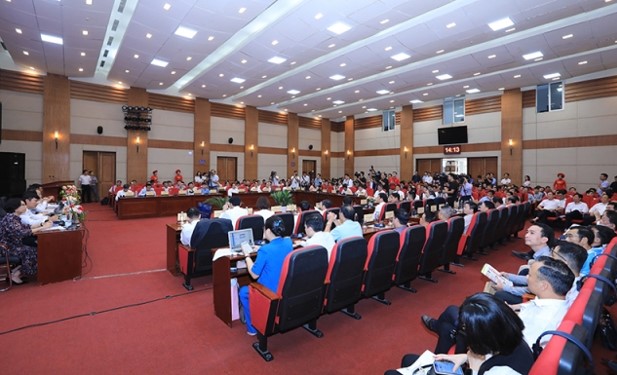
With the positions of major cities like Ho Chi Minh City, Hanoi, Hai Phong, Quang Ninh, and other provinces and cities in Vietnam in general, land is becoming a scarce or increasingly scarce resource. If we want to maintain a sustainable industry in the future, then the eco-industrial zone model in the next 10-20 years must be a role model. In fact, during the 2020-2023 period, the Swiss government is supporting the conversion of three industrial zones in Ho Chi Minh City, Hai Phong, and Dong Nai into eco-industrial zones following international frameworks, with the goal of replicating this model nationwide.
In my personal opinion, in addition to existing policies, there should be guidance on standards and technical standards from ministries and technical guidance from domestic and international experts, especially for industrial symbiosis networks and circular economic solutions. At the same time, there is also a need to supplement financial incentives (such as tax exemptions, reductions, land rental fees, and preferential credit loans) for industrial zones, eco-zones, and eco-businesses to encourage businesses to undertake transformation and build new eco-industrial zones – emphasized Dr. Tran Thi Hong Minh.
Furthermore, Dr. Minh also noted that the development of industrial zones in general and eco-industrial zones in particular must contribute directly and strongly to green growth, emission reduction, and especially to enhance the social responsibility of businesses. Industrial zones should be favorable places to experiment with new development spaces. The key is to maintain connectivity and avoid industrial zones replicating each other's models, leading to excessive competition instead of efficient cooperation.
The discussion moderator, Mr. Dau Anh Tuan - Deputy Secretary General, Head of VCCI Legal Department, stated that this was a discussion session with a wealth of information from practical experience. The discussion featured three important groups of speakers, including experts, government regulatory agencies, infrastructure businesses in industrial zones, and business associations.

Mr. Dau Anh Tuan – Deputy Secretary General, Head of VCCI Legal Department
EXPERIENCES IN CONNECTING INDUSTRIAL ZONES ABROAD AND LESSONS FOR VIETNAM
Sharing his insights on the topic "Experiences in connecting industrial zones abroad and lessons for Vietnam," Professor Ha Ton Vinh
explained why I chose Dubai as a model for experiences relevant to Vietnam. In Dubai, there are 7 Emirates in the United Arab Emirates (UAE), and among them, 4 Emirates are very dynamic, similar to 4 provinces and cities in Vietnam, namely Hung Yen, Hai Duong, Hai Phong and Quang Ninh. Dubai's 4 industrial zones started from these Emirates and became driving forces and factors for development.
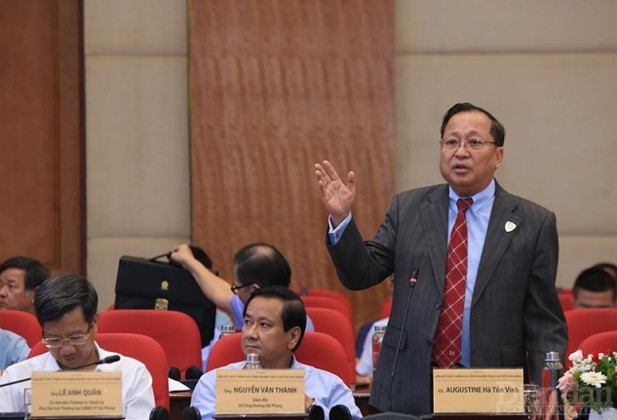
Professor Ha Ton Vinh
In 1971, the UAE was established. By 1968, the UAE had only 180,000 inhabitants. However, by 2023, the UAE had approximately 10 million people, a GDP of $520 billion, and a per capita GDP of $45,000.
Currently, the United Arab Emirates (UAE) with its 7 Emirates operates 46 industrial zones with over 40 business sectors, including airport industrial zones, cargo transit industrial zones, medical industrial zones, pharmaceutical research and production industrial zones, floral and agricultural industrial zones, internet industrial zones, precious metal industrial zones (gold, silver, diamonds, gemstones), fashion design industrial zones, education industrial zones, automobile manufacturing industrial zones, textile industrial zones, and sports industrial zones, among others.
Professor Ha Ton Vinh stated that in just over 30 years, industrial zones and economic zones in the UAE have become key factors in the economic development of the 7 Emirates. Initially, these zones were established to diversify the economy, which heavily relied on oil, and attract foreign investment. By 2020, this region had become one of the most attractive global economic and commercial areas. Since their establishment, JAFZA (Jebel Ali Free Zone Authority) had only 19 companies participating in their industrial zones, but now there are more than 8,000 operating companies. Thanks to favorable policies, many industrial zones have attracted multinational corporations to set up specialized zones in areas like technology, communications, design, sports, and education. For instance, CNN, MBC, Microsoft, and Siemens have established a presence there. Ras Al Khaiman Economic Zone (RAKEZ), located just an hour from the center, has attracted more than 15,000 operating companies in 50 different sectors. These are the differences in the industrial zones of the United Arab Emirates.
"According to my experience, the industrial zones in Dubai do a lot, each industrial zone specializes in something. In Vietnam, we have comprehensive industrial zones for various sectors," said Professor Vinh.
Furthermore, according to professor Ha Ton Vinh, in the United States, wherever Americans go, there is a Chamber of Commerce, similar to how Vietnam has the Vietnam Chamber of Commerce and Industry. Currently, there are no American industrial zones in Vietnam, so perhaps we should consider having American industrial zones (not entirely 100% American-owned). If we have American industrial zones, it would raise the profile of Hai Phong. What do we need to do to change, adapt, and become key industrial zones? In the internet revolution, we cannot do anything without the internet for digital transformation and the digital economy. Our industrial zones and economic zones must change and innovate. Entrepreneurship is not just for students, but it is also for startup businesses, even more so for government startup initiatives. We are a nation of entrepreneurs.
ENHANCING THE EFFICIENCY AND CONNECTIVITY OF INDUSTRIAL ZONES
Mr. Hoang Trung Kien - Head of the Management Board of Economic Zones and Industrial Zones of Quang Ninh Province, stated that as the easternmost province of the homeland, Quang Ninh is an important and bustling trade gateway for ASEAN with the Northeast Asian region. Quang Ninh is also one of the few localities that currently have all three models, including industrial zones, coastal economic zones, and border economic zones. This is an advantage for the province to cooperate with other localities along the eastern highway axis in developing industrial zones.

Mr. Hoang Trung Kien - Head of the Management Board of Economic Zones and Industrial Zones of Quang Ninh Province
To leverage the strengths of localities and enhance the efficiency and connectivity of industrial zones and economic zones along the eastern highway axis, Mr. Hoang Trung Kien believes that localities need to propose the construction and issuance of a Law on Industrial Zones and Economic Zones to create a legal framework for the establishment and development of industrial zones and economic zones. Furthermore, they should propose specialized mechanisms and policies for the development of industrial zones and economic zones to ensure a shared development and connection for all four provinces.
Secondly, localities should collaborate to review the planning of industrial zones and economic zones to develop a direction for industries that are suitable for their potential advantages, creating a symbiotic industrial ecosystem.
Thirdly, provinces along the eastern highway axis should organize joint investment promotion activities. Based on the planning direction and labor demands of industrial zones and economic zones, localities should work together to create and issue investment promotion materials for industrial zones and economic zones, ensuring the efficiency and connectivity of industrial zones and economic zones.
Lastly, with the direction to develop industrial zones on a scale three times larger than the current scale, an important issue to be addressed is the labor force. Localities should establish a shared database on the labor force, review the labor demands of industrial zones and economic zones, and based on that, develop plans and methods for training a suitable labor force tailored to the needs of each locality's vocational training facilities. This will help avoid situations where there is an excess or shortage of labor. Additionally, it is essential to ensure the rights, income, and living conditions of laborers, as Quang Ninh has done through housing policies for workers.
MULTI-TIERED VALUE DEVELOPMENT SPACE
Sharing at the forum, Mr. Bui Ngoc Hai, Deputy Head of the Management Board of Economic Zones and Industrial Zones of Hai Phong, said, "We highly value the initiative to implement vertical linkages along the eastern highway axis. I believe this is not just a physical highway but a highway of prosperity, investment, and information. This is a development space with multiple tiers of value. New production models, green economy, and circular economy have opened up slow development spaces for us and have allowed us to make breakthroughs."
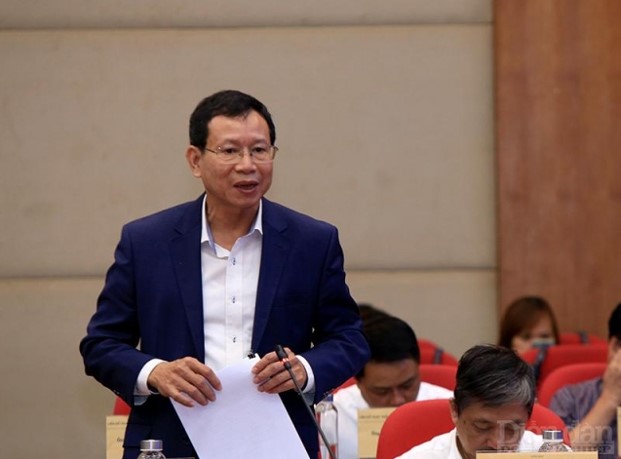
Mr. Bui Ngoc Hai, Deputy Head of the Management Board for Economic and Industrial Zones of Hai Phong
In his role as a driving force for the region's development, Mr. Bui Ngoc Hai has a clear understanding of the role and importance of enhancing regional connectivity to promote economic development among the four provinces and cities. This connectivity aims to facilitate the flow and connection of resources, complement each other's advantages, and optimize the efficient utilization of economic resources. Strengthening regional linkages and appropriate cooperation that align with the needs and strengths of local areas within the region will create unity and collective strength for each locality, the entire region, and the entire country, especially in the areas of infrastructure development, industrial park development, economic zones development, and the provision of high-quality labor force and skilled workers.
Furthermore, it's essential to leverage the strengths of each locality to enhance the connectivity of industrial parks and economic zones along the eastern highway corridor. To achieve this, there must be a mutual understanding among these areas, beginning with the establishment of a data system providing information about industrial clusters in the region, their needs, and priorities for development.
"To avoid merely making commitments, we need a set of criteria to assess the effectiveness of these linkages, and there must be a monitoring agency. This is a prerequisite that may be challenging but is necessary to create breakthroughs and think beyond conventional methods," Mr. Hai stated.
Secondly, for businesses to engage in these linkages, they must see the benefits. For instance, if an industrial park uses shared infrastructure like steam stations, compressed air, waste treatment facilities, etc., what are the benefits, and how can this encourage businesses to collaborate and create specialized industrial clusters, stimulating investors to invest in shared infrastructure for greater efficiency?
Thirdly, the collaboration between businesses when implementing circular economy practices is not just a trend but a necessity. The more we proactively establish a circular economy, the more competitive our businesses become. In the early stages of business development, companies tend to take fewer risks, so the government and associations must provide support. Drawing from the experience in South Korea, the government fully sponsored feasibility studies when converting comprehensive industrial zones into eco-industrial parks. "We need mechanisms to reduce risks and attract businesses. Besides the efforts of businesses, there must be coordinated government policies," emphasized Mr. Hai.
We need more initiatives like the Eastern Highway Corridor to further improve regional connectivity.
As stated at the forum, Mr. Bruno Jaspaet, the CEO of DEEP C Industrial Complex, shared that their company is currently present in two provinces, Hai Phong and Quang Ninh, with a special focus on Hai Phong for the past 26 years. When the eastern highway system was established, it brought numerous advantages and support for business development. Previously, interregional transportation was extremely challenging, but the implementation of the eastern highway has significantly reduced travel times.

Mr. Bruno Jaspaet - CEO of DEEP C Industrial Complex
"In the near future, DEEP C will also expand into Lach Huyen in the city of Hai Phong. We hope that with the current collaboration, the infrastructure will continue to improve," shared Mr. Bruno Jaspaet.
According to Mr. Bruno Jaspaet, any investor considering an investment project will ultimately focus on seaport infrastructure as the ultimate goal. Therefore, in addition to road infrastructure, it is essential to develop infrastructure at seaports.
"In my opinion, we need to utilize the current opportunities most efficiently and consistently. In the near future, a delegation from Hai Phong will go to Japan to learn from their experiences. So, since we already have a connection between the four provinces, it's necessary to send representatives from each province to participate in this delegation. This will allow us to learn and have a shared understanding to apply these lessons across the provinces. All investors are looking for this. Besides land and infrastructure incentives, the four provinces along the eastern highway corridor already have a good highway system. It's essential to further develop green energy and establish training centers to educate skilled labor," Mr. Bruno Jaspaet stated.
At the forum, Mr. Bruno Jaspaet mentioned that there are many initiatives for sustainable development nowadays, and their company has been building eco-industrial parks with a focus on sustainable development. Therefore, to achieve the stated goals and develop industrial zones into sustainable eco-industrial parks, there is a need for comprehensive policies, laws, regulations, and synchronized measures.
"To attract sustainable development projects, in addition to leveraging land and premises incentives, it's necessary to use tax tools effectively. The provinces need to have a unified regulation on land and premises use, as well as wastewater management, in a reasonable manner because in the near future, without proper treatment, it will be challenging to develop," he emphasized.
In the future, it is essential to develop industrial zones into eco-industrial parks, develop railways and inland waterways in a coordinated manner to promote the development and operation of infrastructure facilities within industrial zones. There is a need for more innovative initiatives similar to the development of the eastern highway corridor," Mr. Bruno Jaspaet highlighted.
CONNECTING DEVELOPMENT
Mr. Paul Tonkes - Deputy Director of Core 5 Vietnam, stated that they currently have projects in Hai Phong and Quang Ninh with pre-built factories ranging from 3,600 square meters, and they are also attracting other investors into their factory spaces. Throughout the various stages of development, they require all factories in their projects to meet the specified requirements and standards.
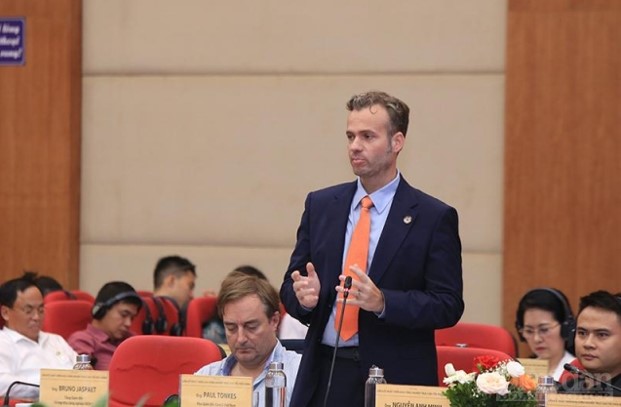
Mr. Paul Tonkes - Deputy Director of Core 5 Vietnam
"We have implemented projects in Southern Vietnam, connecting supply chains in Brazil and the United States. The development opportunities here are very unique and offer many benefits to investors. Notably, there are collaborations between Vietnam and other countries, and these bilateral partnerships have developed over many years. Whenever there are projects, task forces are established to support large projects or the transition to Net Zero production chains. This process is synchronized across all provinces and cities," said Mr. Paul Tonkes.
Furthermore, all provinces and cities provide support to investors when they come to invest, especially in industrial zones like Deep C, which also receive support from infrastructure development units within the industrial zone.
In our role in developing factories and workshops, we have observed the flexibility of provinces and cities in creating conditions for investors, which helps investors avoid concerns about growth-related issues. All policy projects are related to greener development, industrial symbiosis, sustainable development, and environmental protection. "In particular, we have noticed significant collaborative support from the People's Committees of provinces and cities when planning the development of industrial zones in parallel with infrastructure development in local areas to facilitate development," he said.
BUILDING AND OPERATING INVESTMENT LINKAGES IS NECESSARY
Sharing at the forum, Mr. Nguyen Trung Kien - Head of the Management Board for Industrial Zones in Hai Duong Province, mentioned that Hai Phong and Quang Ninh have several differences from Hai Duong and Hung Yen, and of course, economic zones will have different incentives compared to industrial zones. However, why should we share information, and why should we promote joint usage? We believe that there are industries that should invest near the sea and others that should be farther away from the sea to avoid being affected by coastal climates.
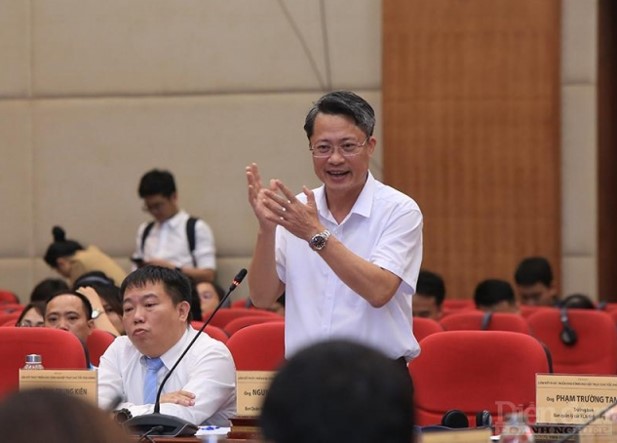
Mr. Nguyen Trung Kien - Head of the Management Board for Industrial Zones in Hai Duong Province
As the Chairman of VCCI mentioned, we have over 20 years left to become an industrialized nation. With such a significant direction, we must invest in industry and prioritize it. "I believe that Decree No. 35/2022/NĐ-CP is not strong enough because there are many sectors within the industries. I agree with the idea of having a dedicated law for Economic Zones, Export Processing Zones, and Industrial Zones (EEIZs)," Mr. Kien stated.
Currently, Hai Phong will implement policies differently from Hung Yen, and similarly, within organizations, there are differences in assignment and delegation of responsibilities in areas such as construction, environment, or labor. However, the purpose of Decree No. 35/2022/NĐ-CP is to act as a single point of contact to provide the most favorable conditions for investors. If Hai Phong and Quang Ninh have advantages in terms of tax incentives, administrative reforms, etc., but Hai Duong and Hung Yen are not thoroughly delegated responsibilities due to issues with non-uniform laws.
Therefore, "we hope to have separate laws for EEIZs. At the same time, we will continue to advise the Ministry of Planning and Investment to propose the addition of a Law on Industrial Zones and Economic Zones to create the highest legal framework to enhance effectiveness and coherence in planning, construction, and operation of EEIZs. This should involve delegation of responsibilities directly to the Management Boards to comprehensively carry out state management functions for EEIZs, including inspection, to ensure uniformity and consistency in state management mechanisms for EEIZs. We need this to resolve contradictions and overlaps in the management mechanisms concerning areas like construction, environment, and labor within EEIZs," he said.
Ministries and sectors should actively delegate authority to the Management Boards to perform specialized state management tasks effectively and play the role of a "one-stop-shop" for EEIZs. For example, in the management of planning and construction for industrial zones in Hai Duong Province, it is currently assigned to three units at the provincial and district levels, leading to challenges for investors in terms of procedures and time, affecting investment progress and investor satisfaction within the management framework. It is essential to determine, establish, and operate an investment mechanism where "what investors need is a matter for the state to resolve."
DEVELOPING TRANSPORTATION TO CONNECT WITH OTHER PROVINCES
Mr. Pham Truong Tam - Head of the Management Board for Industrial Zones in Hung Yen Province, stated that Hung Yen is a province located at the forefront of the Hanoi - Hai Phong expressway. With this location, there are strengths and the need for connectivity between regions to fully leverage Hung Yen's advantages. Hung Yen has a natural land area of approximately 930 km2 and a population of about 1.3 million people.

Mr. Pham Truong Tam - Head of the Management Board for Industrial Zones in Hung Yen Province
In recent years, the growth rate of Hung Yen has followed the general trend of provinces and cities along the Eastern expressway, which is experiencing growth. With this spirit, Hung Yen, like other provinces and cities, aims to build a production area that generates economic and social development for the province. There are three pillars to this approach. First, the focus is on developing transportation to connect with neighboring provinces. Currently, connectivity through transportation with neighboring provinces and cities in the region is crucial. The infrastructure for road intersections on the expressway and parallel routes needs to be synchronized to handle large traffic volumes smoothly.
Based on Hung Yen's industrial development experience from 2003 to the present, we have learned that industrial relocation depends on transportation. The current industrial complex comprises about 7 industrial zones with an area of approximately 2,000 hectares, situated in the heart of the province. Practical observation has shown that the infrastructure in industrial zones requires an efficient transportation system. Even if we have available land, without proper transportation connectivity, it is challenging to attract businesses.
Secondly, national-scale industrial zones play a crucial role. For instance, Hung Yen has Japanese industrial zones that have expanded to phase 3, covering about 600 hectares. Here, there are around 100 Japanese enterprises. When attracting other investors, the business community will exchange information on interconnectivity, legal consulting, and other legal matters related to Vietnamese law. So, when a single national representative from a certain country's industrial zone attracts large investors, it will attract capital accordingly.
Fourth, we need to address the issue of human resources. This includes both local and non-provincial labor sources. From our observations, through careful monitoring, about 30-40% of the workforce in our province comes to work in industrial zones in Hung Yen from other provinces. Therefore, training and attracting human resources must be systematic and clear. Provinces and cities need to balance supply and demand and share resources with each other. Currently, the connection between universities, vocational schools, and businesses is still fragmented, and businesses are primarily responsible for recruiting. The state management agencies have not yet established a system. We can raise the issue of a labor force training system to collaborate with businesses to create job opportunities for graduating students, which is beneficial for both students and businesses.
Currently, meetings among the four provinces and cities are just beginning, and there will be more in the future. I hope that future meetings will focus more on specialized areas. For example, data sharing—many businesses invest in all four provinces and cities rather than just one. However, state agencies are not aware of this because they actively seek resources.
We propose the establishment of an Association of Industrial Zones, including businesses within industrial zones, to facilitate communication. Additionally, infrastructure connection needs to be reviewed among provinces. Currently, we face the challenge of expanding industrial zones while administrative personnel remain static or decrease. Meanwhile, industrial zone management committees are doing an excellent job.
"We very much hope to be granted more management authority for industrial zone management committees. Regarding the common proposals of provinces and cities, we also hope to receive additional land allocation targets for Hung Yen province," he said.
CREATING GREEN SPACES WITHIN INDUSTRIAL ZONES
Mr. Truong An Duong, CEO of the Northern region and the residential real estate sector of Frasers Property Vietnam, stated that they are committed to developing real estate and industrial zone services, as well as industrial zone infrastructure, sustainably. Frasers' projects are green-certified and contribute to the development of sustainable and green industrial zones along the Eastern expressway. In the development of sustainable industrial real estate, Frasers emphasizes three factors: people, businesses, and the environment, ensuring sustainable development from the design phase through construction and subsequent operation.
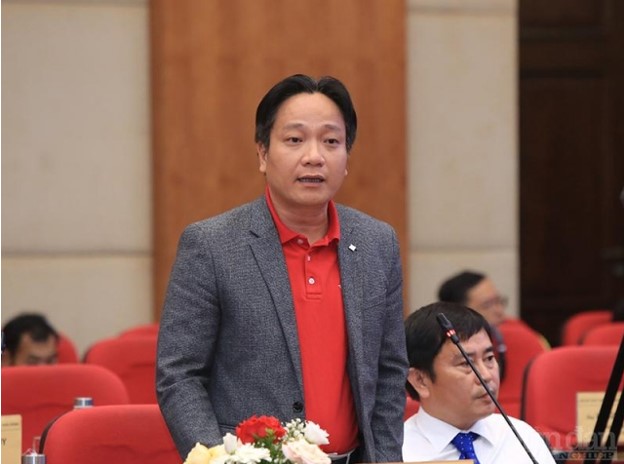
Mr. Truong An Duong, CEO of the Northern region and the residential real estate sector of Frasers Property Vietnam
In the urban planning and design phase, Frasers is willing to sacrifice construction space on its projects to create more green spaces for planting trees and building parks within industrial zones. This commitment serves to protect the environment and provide recreational spaces for factory workers, promoting physical well-being and ensuring their health, thereby enriching their overall quality of life.
Regarding businesses, Frasers proactively collaborates with partners to implement green technology and sustainable development practices, including the use of renewable energy within industrial zones. This approach contributes to energy conservation for businesses and aligns with the inevitable development trends in the near future for industrial zones. It also attracts foreign investment, especially green capital from Europe and the United States, while offering green consumer products that meet global consumer standards and certifications.
ECOSYSTEM CONNECTIVITY ACROSS MULTIPLE LEVELS AND CLOSELY INTEGRATED
Mr. Nguyen Anh Minh, Deputy General Director of Shinec Corporation, the investor of Nam Cau Kien Industrial Park, emphasized that through the collaboration of businesses within industrial zones and the connectivity between industrial zones within the province, a regional network will be established, particularly connecting with the Eastern expressway. This network will create an ecosystem of multiple interconnected layers and a tightly integrated system. Based on practical investment experiences in Hai Phong and various provinces and cities nationwide, and considering the shared mindset of investors coming to Vietnam, we cannot overlook the role of on-site investment promotion. The companies manufacturing here are the potential and loyal customers when attracting international investors.

Mr. Nguyen Anh Minh, Deputy General Director of Shinec Corporation and the investor of Nam Cau Kien Industrial Park, stated, "This is the short and optimal path for us to attract investments through on-site investment attraction.
In addition, I would like to emphasize the need for unity and efficiency, not only within industrial zones but also in our overall approach. Therefore, we require a mechanism for effective coordination and collaboration among the four provinces and cities along the Eastern expressway. We propose the establishment of an Association for Regional Connectivity, including industrial zones," Mr. Nguyen Anh Minh said.
FOCUSING ON THE DEVELOPMENT OF LOGISTICS SERVICES
Mr. Tran Tien Dung, Chairman of the Hai Phong Logistics Association, mentioned that the developing transportation system is turning the Hanoi - Hai Phong - Quang Ninh economic growth axis into a primary factor driving the growth of the key economic region in Northern Vietnam. This region is forming a "golden triangle" with the potential to develop a megalopolis, connecting with the Guangxi region and the Guangdong - Hong Kong economic area.
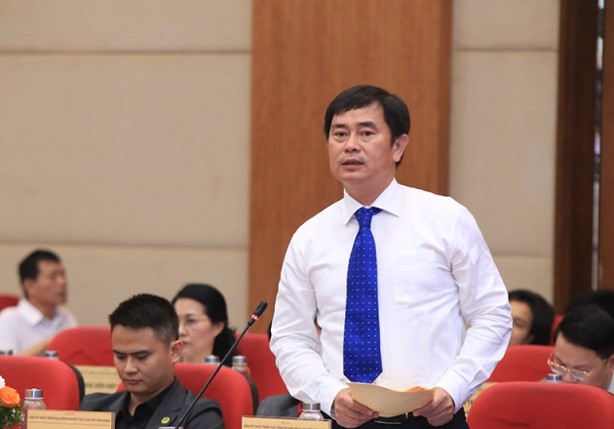
Mr. Tran Tien Dung, Chairman of the Hai Phong Logistics Association
According to statistics from the Vietnam Logistics Research and Development Institute (VLI), the infrastructure of economic zones, industrial parks, and industrial clusters along the Hanoi - Hai Phong - Quang Ninh corridor is considered one of the most well-developed in the key economic region of Northern Vietnam (see Figure 1). The average occupancy rate of industrial parks is 43% in Quang Ninh, 96% in Hanoi, and 68% in Hai Phong (the national average is 70.9%) (Quang Ninh Provincial People's Committee, 2022).
With the number and scale of large industrial zones, export-processing zones, and economic zones that have completed infrastructure, this will be a significant source of demand when regional connectivity is effectively implemented in the future...
Through the evaluation of potential logistics service development areas in the Hanoi - Hai Phong - Quang Ninh economic triangle, the VLA proposes to leverage the connectivity of the Eastern expressway, including the Hanoi - Hai Phong expressway; Hai Phong - Ha Long expressway; Ha Long - Van Don expressway; Van Don - Mong Cai expressway, and connect to border crossings with China to focus on developing logistics services such as E-commerce logistics; Cross-border logistics; Seaport logistics; and Tourism logistics.
"To develop these services, we need to initially invest in developing logistics infrastructure for seaport hinterlands; cold storage systems for agricultural products; warehouse and logistics centers at border crossings," Mr. Tran Tien Dung shared.
Contributing to the development of the logistics system along the Hanoi - Hai Phong - Quang Ninh economic corridor, Mr. Dung believes that VLI has been entrusted with conducting research projects, including "Scientific research to serve the construction of the Hai Phong seaport brand development strategy by 2030, with a vision to 2045." In the third quarter of 2023, VLI will also receive the project "Research on developing the logistics sector of Quang Ninh province by 2035, with a vision to 2045."
"These are pivotal projects for both Hai Phong and Quang Ninh and can be seen as a driving force to enhance regional connectivity, especially when the two localities along the Hanoi - Hai Phong - Quang Ninh corridor are conducting logistics projects within a similar timeframe with the renowned logistics consulting unit VLI, which is under the VLA," Mr. Dung expressed.
In his concluding remarks at the forum, Mr. Pham Tan Cong, Chairman of the Vietnam Chamber of Commerce and Industry, stated that we have had three lively discussions, sharing experiences, raising issues, and making recommendations related to the theme of "Linking the development of the Eastern expressway industrial zone." The synthesis of opinions presented at the forum also shows that industrial zone development is a prerequisite for the industrialization of localities.

Mr. Pham Tan Cong - Chairman of the Vietnam Chamber of Commerce and Industry
However, the Chairman of VCCI emphasized the need for a development strategy and cooperation among localities in industrial zone development. He also asserted that economic connectivity among the four provinces and cities, including Hai Phong, Hai Duong, Hung Yen, and Quang Ninh, is essential for the development of businesses, industrial zones, and regions.
The opinions expressed also highlighted that we must become a "prosperous axis." In Resolution 30 on the development of the Red River Delta region, we have a position to become a driving force for regional development. In reality, these four provinces and cities form a triangle and are considered the development triangle of the country. We aspire for this region to become the leading dynamic area in the nation.
The forum heard speeches from Mr. Nguyen Van Tung - Chairman of Hai Phong City People's Committee and three keynote speeches from representatives of the Vietnam Association for Building and Development, CIEM Economic Institute, and the Ministry of Natural Resources and Environment on major issues related to industrial zone development in the region.
In addition to the speech by Professor Ha Ton Vinh, we have nine opinions from representatives of management boards of industrial zone development. Professor Ha Ton Vinh mentioned the industrial zone model in the United Arab Emirates (UAE) - a small country that was once entirely dependent on oil and gas resources, but now oil and gas account for only 5% of its GDP. "We visited and studied various models, including industrial zone models, and found that these industrial zones have helped the UAE successfully transform its economic structure," emphasized Mr. Pham Tan Cong.
China is also a successful model in industrial zone development. Therefore, Vietnam must industrialize by successfully implementing industrial zones. This is the role that the four localities are determined to fulfill by developing industrial zone development models. The discussions also emphasized the need to develop industrial zones within sub-regions, enhance efficient connectivity, focus on sustainable industrial zone development, and attract businesses and investors with awareness and orientation toward sustainable development in industrial zones.
Especially, the Chairman of VCCI needs to enhance the quality and efficiency of services within industrial zones, establish interconnected logistics centers, and build the Eastern expressway as a leading dynamic development area in Vietnam with a favorable business environment. This is clearly reflected in the annual PCI assessment, where all four localities have very good PCI scores, with Quang Ninh and Hai Phong standing out.
In my opinion, this forum is just the beginning of linking the Eastern expressway industrial zones, and in the near future, there needs to be active involvement from industrial zone developers, proactive participation from management boards, and support from the Party committees and governments... We have only 22 years left to strive to make Vietnam a developed country, and we need to accelerate the pace of industrialization and economic restructuring. This must be achieved, especially for the four provinces and cities along the Eastern expressway as Vietnam becomes a developed nation.
"VCCI is committed to standing side by side with the provinces, cities, and local People's Committees to realize this aspiration. In September, the Economic Connectivity Council will have an operational plan to promote a more substantial and effective economy among the four localities. At the same time, the Eastern Expressway Business Council will be officially established to connect businesses in the four localities to implement development strategies," emphasized the Chairman of VCCI.
In the coming months, VCCI will also organize Investment Promotion Forums in Japan, Taiwan, Europe, and the United States to encourage investment from businesses in the region.
According to HANH THOA - HANG DIEM - LAN NGAN - HIEN PHUONG - TUAN NGOC (Business Forum Magazine)
By: Translator: LeAnh-Bizic
---------------------------------------------
Same category News :






